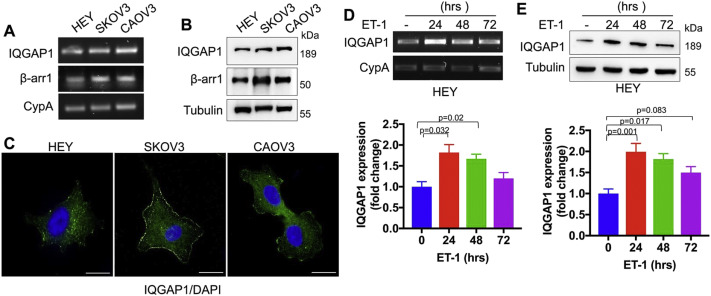当前位置:
X-MOL 学术
›
Matrix Biol.
›
论文详情
Our official English website, www.x-mol.net, welcomes your
feedback! (Note: you will need to create a separate account there.)
Regulation of extracellular matrix degradation and metastatic spread by IQGAP1 through endothelin-1 receptor signalling in ovarian cancer.
Matrix Biology ( IF 4.5 ) Pub Date : 2018-10-25 , DOI: 10.1016/j.matbio.2018.10.005 Lidia Chellini 1 , Valentina Caprara 1 , Francesca Spadaro 2 , Rosanna Sestito 1 , Anna Bagnato 1 , Laura Rosanò 1
Matrix Biology ( IF 4.5 ) Pub Date : 2018-10-25 , DOI: 10.1016/j.matbio.2018.10.005 Lidia Chellini 1 , Valentina Caprara 1 , Francesca Spadaro 2 , Rosanna Sestito 1 , Anna Bagnato 1 , Laura Rosanò 1
Affiliation

|
The invasive phenotype of serous ovarian cancer (SOC) cells is linked to the formation of actin-based protrusions, invadopodia, operating extracellular matrix (ECM) degradation and metastatic spread. Growth factor receptors might cause engagement of integrin-related proteins, like the polarity protein IQ-domain GTPase-activating protein 1 (IQGAP1), to F-actin core needed for invadopodia functions. Here, we investigated whether IQGAP1 forms a signalosome with endothelin-1 (ET-1)/β-arrestin1 (β-arr1) network, as signal-integrating module for adhesion components, cytoskeletal remodelling and ECM degradation. In SOC cells, ET-1 receptor (ET-1R) activation, besides altering IQGAP1 expression and localization, coordinates the binding of IQGAP1 with β-arr1, representing a "hotspot" for ET-1R-induced invasive signalling. We demonstrated that the molecular interaction of IQGAP1 with β-arr1 affects relocalization of focal adhesion components, as vinculin, and cytoskeleton dynamics, through the regulation of invadopodia-related pathways. In particular, ET-1R deactivates Rac1 thereby promoting RhoA/C activation for the correct functions of invasive structures. Silencing of either IQGAP1 or β-arr1, or blocking ET-1R activation with a dual antagonist macitentan, prevents matrix metalloproteinase (MMP) activity, invadopodial function, transendothelial migration and cell invasion. In vivo, targeting ET-1R/β-arr1 signalling controls the process of SOC metastasis, associated with reduced levels of IQGAP1, as well as other invadopodia effectors, such as vinculin, phospho-cortactin and membrane type 1-MMP. High expression of ETAR/β-arr1/IQGAP1 positively correlates with poor prognosis, validating the clinical implication of this signature in early prognosis of SOC. These data establish the ET-1R-driven β-arr1/IQGAP1 interaction as a prerequisite for the dynamic integration of pathways in fostering invadopodia and metastatic process in human SOC.
中文翻译:

IQGAP1通过内皮素-1受体信号传导调节卵巢癌中细胞外基质的降解和转移扩散。
浆液性卵巢癌(SOC)细胞的侵袭性表型与基于肌动蛋白的突起,侵袭,足细胞外基质(ECM)降解和转移扩散的形成有关。生长因子受体可能导致整联蛋白相关蛋白(如极性蛋白IQ域GTPase激活蛋白1(IQGAP1))与侵袭性伪足功能所需的F-肌动蛋白核心结合。在这里,我们调查了IQGAP1是否与内皮素1(ET-1)/β-arrestin1(β-arr1)网络形成信号体,作为粘附成分,细胞骨架重塑和ECM降解的信号整合模块。在SOC细胞中,除了改变IQGAP1的表达和定位外,ET-1受体(ET-1R)的激活还协调了IQGAP1与β-arr1的结合,代表了ET-1R诱导的侵袭性信号传递的“热点”。我们证明,IQGAP1与β-arr1的分子相互作用通过调节invadopodia相关途径,影响粘着斑成分的重新定位,如纽蛋白和细胞骨架动力学。特别是,ET-1R使Rac1失活,从而促进RhoA / C激活,以实现侵入结构的正确功能。使IQGAP1或β-arr1沉默,或用双重拮抗剂美西坦阻滞ET-1R活化,可防止基质金属蛋白酶(MMP)活性,内足功能,跨内皮迁移和细胞侵袭。在体内,靶向ET-1R /β-arr1信号传导可控制SOC转移过程,与IQGAP1以及其他invadopodia效应物(如纽蛋白,磷酸皮质激素和膜型1-MMP)水平降低相关。ETAR /β-arr1/ IQGAP1的高表达与不良预后呈正相关,验证了该标志物在SOC的早期预后中的临床意义。这些数据确定了ET-1R驱动的β-arr1/ IQGAP1相互作用是动态整合促进人类SOC中的侵袭和转移过程的先决条件。
更新日期:2019-07-05
中文翻译:

IQGAP1通过内皮素-1受体信号传导调节卵巢癌中细胞外基质的降解和转移扩散。
浆液性卵巢癌(SOC)细胞的侵袭性表型与基于肌动蛋白的突起,侵袭,足细胞外基质(ECM)降解和转移扩散的形成有关。生长因子受体可能导致整联蛋白相关蛋白(如极性蛋白IQ域GTPase激活蛋白1(IQGAP1))与侵袭性伪足功能所需的F-肌动蛋白核心结合。在这里,我们调查了IQGAP1是否与内皮素1(ET-1)/β-arrestin1(β-arr1)网络形成信号体,作为粘附成分,细胞骨架重塑和ECM降解的信号整合模块。在SOC细胞中,除了改变IQGAP1的表达和定位外,ET-1受体(ET-1R)的激活还协调了IQGAP1与β-arr1的结合,代表了ET-1R诱导的侵袭性信号传递的“热点”。我们证明,IQGAP1与β-arr1的分子相互作用通过调节invadopodia相关途径,影响粘着斑成分的重新定位,如纽蛋白和细胞骨架动力学。特别是,ET-1R使Rac1失活,从而促进RhoA / C激活,以实现侵入结构的正确功能。使IQGAP1或β-arr1沉默,或用双重拮抗剂美西坦阻滞ET-1R活化,可防止基质金属蛋白酶(MMP)活性,内足功能,跨内皮迁移和细胞侵袭。在体内,靶向ET-1R /β-arr1信号传导可控制SOC转移过程,与IQGAP1以及其他invadopodia效应物(如纽蛋白,磷酸皮质激素和膜型1-MMP)水平降低相关。ETAR /β-arr1/ IQGAP1的高表达与不良预后呈正相关,验证了该标志物在SOC的早期预后中的临床意义。这些数据确定了ET-1R驱动的β-arr1/ IQGAP1相互作用是动态整合促进人类SOC中的侵袭和转移过程的先决条件。











































 京公网安备 11010802027423号
京公网安备 11010802027423号